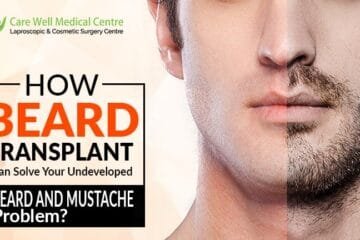As Dr. Sandeep Bhasin, I am here to guide you through the fascinating world of beard transplants. For many, achieving the perfect beard is a journey filled with trials and experiments, from grooming techniques to dietary supplements. However, occasionally, our genetic makeup limits the potential growth of our beard. This is where beard hair transplants step in, offering a permanent solution for those seeking fuller facial hair. While this procedure provides impressive results, many wonder, do beard hair transplants leave scars? Understanding the scarring risks and healing process is essential before considering this treatment.
In this article, we’ll delve into the topic of scarring post-beard transplant surgery. We will explore why scarring occurs, methods to minimize it, and the crucial role of selecting the right hair transplant surgeon and clinic. So, let’s embark on this informative journey together to uncover the facts about beard transplant scars.
Beard Transplant Types and Causes:
So, where do these scars come from? Well, during a beard transplant, surgeons typically take hair from the back of your head, near the neck. This area is chosen because it usually has healthy, strong hair follicles. Different methods are used to carefully extract these follicles, but they all involve making tiny cuts in your skin to remove them. This is where the scars form, even though they might not show up until later.
The next step involves transplanting this hair to your face, usually on your cheeks, chin, or mustache area. Small cuts are made in your skin to place the transplanted hair, but these scars are usually so tiny that you won’t even notice them, especially once your beard grows out.
Size and Shape:
Now, what do these scars look like? Most often, you’ll end up with a fine-line scar where the hair was taken from your head. This scar tends to fade and flatten over time, becoming less noticeable. It’s rare for these scars to be raised or bumpy unless something goes wrong during the surgery or if you don’t take care of the area properly afterward.
As we discuss different beard transplant methods, we’ll also talk about how to minimize these scars over time, so don’t worry too much about them sticking around forever.
Timing and Healing:
Finally, how long does it take for these scars to heal? Well, as they say, time heals all wounds, and that’s mostly true here too. While the swelling and bleeding will go down soon after the surgery, your skin might still feel sensitive for a while. Plus, it takes months for the transplanted hair to fully take root and grow in, so you won’t see the full results right away.
We usually tell our patients to wait about a year before expecting to see the final outcome of their beard transplant. During this period, the scars will continue to heal and fade, so it’s crucial to exercise patience and allow your body the necessary time to perform its healing process.
So, there you have it—the basics of beard transplant scars. Remember, while there might be some scarring involved, the end result is usually worth it for those looking to achieve their dream beard.
Which One Causes Scarring?
Both FUE and FUT methods involve making cuts in the donor area to harvest hair for the transplant. However, the type and visibility of scars differ.
Follicular Unit Excision (FUE):
FUE uses a “hole-punch” technique to extract hair follicles individually. This results in minimal, scattered scars in the donor area. If you keep your hair short, you might notice a patchwork-like pattern of scars, but they’re usually not too noticeable.
Follicular Unit Transplant (FUT):
On the other hand, FUT, also known as “strip surgery,” involves removing a horizontal strip of skin from the donor area. This results in a more significant scar, which can be noticeable, especially from a distance. Although the wound is sealed and heals over time, the scar tends to be more visible compared to FUE scars.
So, when deciding between FUE and FUT for your beard transplant, consider how visible you want the scars to be and discuss your preferences with your surgeon. Ultimately, the skill of the surgeon plays a crucial role in minimizing scarring, so choose wisely and communicate openly about your expectations.
Why Is FUE Preferred for Beard Transplant?
When it comes to getting hair for a beard transplant, both FUE and Follicular Unit Transplant (FUT) methods work, but we usually suggest FUE for a few reasons.
- Reduced Scarring: FUE tends to leave fewer and less noticeable scars compared to FUT. Since beard transplants usually don’t need as much hair as scalp transplants, the smaller scars from FUE are often enough to achieve the desired beard coverage.
- Efficiency: Most beard transplant surgeries don’t require a huge amount of hair, usually fewer than 1,000 grafts. FUE is efficient for these smaller procedures, ensuring no hair goes to waste.
- Flexibility: With FUE, patients have the option for multiple procedures over time, allowing for adjustments and additions to the beard as needed.
Ultimately, the decision between FUE and FUT depends on the patient’s goals and preferences. It’s essential for patients to communicate openly with their surgeon to ensure they get the results they want.
How Can I Minimize Scarring From a Beard Transplant?
If you’re considering a beard transplant, don’t let the idea of scarring discourage you. Modern surgical tools and postoperative treatments make scarring less of a concern. Here’s what you can do to minimize scarring and achieve your desired beard transformation:
- Choose the Right Procedure: Deciding between Follicular Unit Excision (FUE) and Follicular Unit Transplant (FUT) is the first step. Discuss your vision with your surgeon during the consultation, and explore all options to ensure you’re making the best choice for your desired outcome. This planning stage is crucial for natural-looking results without unwanted side effects.
- Pick an Experienced Surgeon: The surgeon’s experience plays a significant role in the success of your procedure. Research thoroughly, read reviews, and examine before & after photos to ensure your surgeon has the expertise needed for your specific goals. Consider factors like ethnicity and age when evaluating their track record.
- Follow Instructions and Follow Up: After surgery, follow your clinic’s post-operative instructions diligently. This may include using topical medications, minimizing movement, and keeping the area clean to promote healing. Regular follow-up appointments with your surgeon ensure that your recovery is progressing as expected. Dr. Sandeep Bhasin, M.S., prioritizes patient care, providing support throughout the recovery process.
In addition to following medical advice, consider using scar-targeting ointments or creams to further minimize scarring. With the right approach and support, you can achieve your desired beard transformation with minimal scarring.
Remember, scarring is a natural part of the process, but with proper care and guidance, you can minimize its impact and enjoy the results of your beard transplant.
How Long Does It Take for New Hairs to Grow in the Scar?
The time it takes for hairs to grow in the scar can vary. Studies show that most patients have significant hair growth, around 75% or more, by the six-month mark after hair transplant surgery. Another study found that between 64% and 95% of transplanted hair survived after about 13 months. Overall, patients rate their satisfaction with hair transplant results very highly, with an average score of 4.6 out of 5.
Conclusion
In conclusion, modern beard transplants offer natural-looking results with minimal scarring. By choosing a skilled surgeon and following post-operative care instructions, you can achieve the beard of your dreams. Reach out to our Care Well Medical Centre team to begin your journey towards a fuller, more confident beard today.
FAQs About Beard Transplants:
Generally, beard transplantation is safe, but like any procedure, there are risks such as infection and scarring. However, modern techniques have minimized these risks.
Scars in the donor area are rare after hair transplantation. If they occur, they usually heal within a few weeks to months.
The NeoGraft Automated Hair Transplant System is a scarless, no-downtime method for hair transplantation.
Beard transplant results are permanent, with substantial growth seen within several months after the procedure.
Minor discomfort and swelling are common, but less common concerns include pain, excess swelling, bruising, redness, infection, and scarring.
There’s no harm in getting a beard transplant at a young age, but waiting until your facial hair thickens naturally in your late 20s or 30s is also an option.
Hair typically doesn’t grow on scars, but a facial hair transplant can provide a more natural-looking beard for men with facial scarring.







